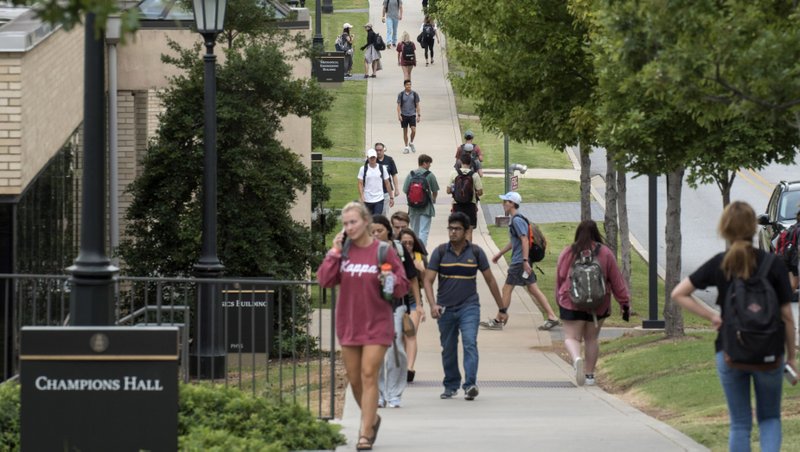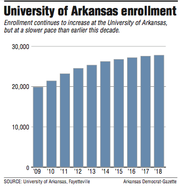FAYETTEVILLE -- Total enrollment has increased at the University of Arkansas, Fayetteville, but once again at a slower pace compared with high-growth years in the recent past.
Enrollment this fall of 27,778, a record high, marked the fourth-straight year of an increase smaller than the previous year, with 220 more students than last fall, according to preliminary data provided by UA that also showed a dip in the size of the freshman class compared to last year.
Growth "has to be controlled in the sense of making sure that we're not adding 5- or 6- or 700 students a year," Chancellor Joe Steinmetz said. "The infrastructure on campus can't handle that kind of growth."
The growth strategy is a shift from earlier this decade, when under former Chancellor G. David Gearhart the UA at times saw year-over-year increases topping 1,500 students, as took place in 2010 and 2011. From fall 2008 to fall 2015, UA saw enrollment grow by more than 7,500 students, an increase of 39 percent, with much of the growth fueled by undergraduate arrivals from outside the state, particularly Texans.
The targeted yearly growth number now is about 300 students, said Steinmetz, UA's top leader since 2016.
Data provided by UA reflect enrollment as of Wednesday, the 11th day of classes, as required by the state Department of Higher Education.
As in recent years, about half of UA's freshman class is again composed of students from outside Arkansas. Out of a first-time, degree-seeking freshmen total of 5,005 students, 2,494 are from Arkansas, about 50 percent.
Last fall, UA reported 5,065 first-time, degree-seeking students, which was the first year freshman enrollment topped 5,000 students, with about 49 percent from Arkansas. The same 49 percent was the proportion of Arkansans in the fall 2016 freshman class, which totalled 4,967 degree-seeking students.
Steinmetz said the size of the student body changes not only because of an incoming class of students, but also depending on trends in a school's graduation and retention rates.
"In my mind, having the freshman class steady and increasing the retention rate is exactly what we want to do," Steinmetz said. The university reported that 83.8 percent of what is considered the 2017 cohort of students returned this fall for their second year of study, up from 82.2 percent a year ago.
For the Arkansan freshmen who arrived this fall, UA spokesman Mark Rushing said about 29 percent are eligible for Pell grants, a form of federal aid awarded to students with exceptional financial need, according to the U.S. Department of Education. For the freshman class as a whole, about 19.8 percent were considered eligible for Pell grants. Rushing said those percentages could change as the year goes on.
The total student enrollment growth included a record number of undergraduates, 23,386, up from the 23,044 undergraduates in fall 2017. Among the undergraduates, 12,823, or about 55 percent, are considered Arkansas residents, said Gary Gunderman, UA's director of institutional research and assessment.
Graduate student totals decreased to 4,024 students, falling for the second straight year.
"That's a bit of a disappointment. I'd like to see us increase that number," Steinmetz said. Last fall, UA reported having 4,161 graduate students.
New transfer students totalled 1,407, including 802 students from Arkansas, Gunderman said. The total was less than the 1,430 new transfer students reported in fall 2017.
Steinmetz said Provost Jim Coleman is having discussions with community colleges including Northwest Arkansas Community College and University of Arkansas-Pulaski Technical College. A goal is to "make sure those students are prepared to come here as far as coursework goes and the pathway is clear in what they need to do," Steinmetz said.
"I think transfers are extremely important. They tend to be our first-generation students, often. They're place-bound. They are often the students with the most financial need," Steinmetz said.
He said the university is working on a five-year enrollment plan to analyze enrollment, including at the graduate level.
Metro on 09/08/2018


